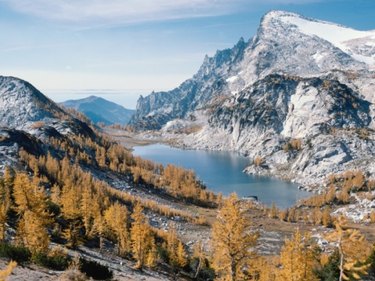
Americans may colloquially call conifers evergreen trees. More correctly, conifers are plants that do not flower but produce seeds in structures called cones. Often conifers retain their needle-like or scale-like foliage through the winter, such as with pine, spruce or arborvitae. A very small number of conifer trees shed their foliage in autumn in an effort to conserve water and energy during the winter months.
Larch
Video of the Day
Larches (Larix spp.) dominate the forests in the high latitudes of Canada, Alaska, Europe, Russia and northern Asia, including Siberia. Rather than risk desiccation in the long, brutally cold and dry winters near the Arctic, larch trees shed their needles each autumn. The soft, feathery needles first turn an attractive yellow to reddish gold before dropping away. Worldwide, about 12 species exist, all being upright in habit. Among the species encountered in gardens in the United States include the European larch (Larix decidua), Japanese larch (Larix kaempferi), Dahurian larch (L. gmelinii), Siberian larch (L. sibirica), western larch (L. occidentalis) and the eastern larch or tamarack (L. laricina).
Video of the Day
Cypress
Three species of cypresses (Taxodium spp.) exist, all native to southern North America. Americans likely know the bald cypress (T. distichum), which is used widely in park settings. The pond cypress (T. ascendens) grows along localized rivers in the extreme southeastern U.S. Cypress trees bear soft, blue-green needles that turn yellow to deep rusty orange before dropping in fall. Extreme drought can cause premature abortion of leaves, too. New needles emerge in spring when warmth and soil moisture are more favorable.
Dawn Redwood
The dawn redwood (Metasequoia glyptostroboides) hails from the forest valleys of central China. This deciduous conifer existed at the time of the dinosaurs and, until the 1940s, was thought to be extinct. From a distance, a dawn redwood looks very much like a bald cypress. In fall, the foliage turns orange-bronze before falling away. Dawn redwood's foliage is extra-feathery with a two-ranked branching structure. The new green shoots branch to form a double rank of twigs that are lined with tiny bright green needles.
Water Pine
Also called Chinese water cypress, the water pine (Glyptostrobus pensilis) grows naturally only in Guangzhou in southeastern China and in nearby Vietnam. In Vietnam, it is endangered as less than 100 specimens remain after extensive deforestation over the decades. In appearance, a water pine looks like a cross between a bald cypress and a dawn redwood. In autumn, water pine's green needles become rich brown before dropping.
False Larch
Across the woodlands of southeastern China is the deciduous conifer known as golden larch or false larch (Pseudolarix amabilis). It resembles true larches until its green needles are viewed up close. The false larch's needles may occur along the twigs but also in rosettes or clustered spurs. In autumn, the needles turn golden orange and fall off.
About Ginkgoes
Occasionally, a nursery may refer to the maidenhair tree (Ginkgo biloba) as a deciduous conifer. Such a designation isn't correct. Ginkgo trees are gymnosperms, like conifer trees, and ginkgo trees do lose their golden yellow fall foliage. Ginkgo, however, does not produce a cone and cannot be discussed as a conifer. Ginkgo produces an evolutionary intermediate structure called a strobilus with a seed inside. It is neither fruit nor cone.